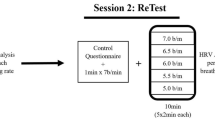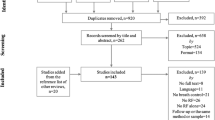Abstract
This study validated a more exact automated method of determining cardiovascular resonance frequency (RF) against the “stepped” protocol described by Lehrer et al. (Appl Psychophysiol Biofeedback 25(3):177–191, https://doi.org/10.1023/a:1009554825745, 2000; in Foundations of heart rate variability biofeedback: A book of readings, The Association for Applied Psychophysiology and Biofeedback, pp 9–19, 2016). Thirteen participants completed a 15-min RF determination session by each method. The “stepped” protocol assesses HRV in five 3-min stationary windows from 4.5 to 6.5 breaths per minute (bpm), decreasing in 0.5 bpm steps. Multiple criteria, subjectively weighted by the clinician, determines RF. For this study, the proposed method used a sliding window with a fixed rate of change (67.04 ms per breath) at each of 78 breath cycles ranging from 4.25 to 6.75 bpm. Its algorithm analyzes IBI to locate the midpoint of the 1-min region of stable maximum peak-trough variability. RF is quantified from breath duration at that point. The software generates a visual display of superimposed HR and breathing data. Thus, the new method fully automates RF determination. Eleven of the 13 matched pairs fell within the 0.5 bpm resolution of the stepped method. Comparisons of LF power generated by the autoregressive (AR) spectral method showed a strong correlation in LF power production by the stepped and sliding methods (R = 0.751, p = 0.000). The “sliding” pacing protocol was favored by 69% of participants (p < 0.02). The new, fully-automated, method may facilitate both in-person and remote HRV biofeedback training. Software is available open-source.


Similar content being viewed by others
References
Aubert, A. E., & Verheyden, B. (2016). Neurocardiology: A bridge between the brain and the heart. In D. Moss & F. Shaffer (Eds.), Foundations of heart rate variability Biofeedback: A book of readings (pp. 42–45). The Association for Applied Psychophysiology and Biofeedback. ISBN 978-0-9842979-5-5.
Berntson, G. G., Cacioppo, J. T., & Quigley, K. S. (1993). Respiratory sinus arrhythmia: Autonomic origins, physiological mechanisms, and psychophysiological implications. Psychophysiology, 30(2), 183–196. https://doi.org/10.1111/j.1469-8986.1993.tb01731.x
ChuDuc, H., NguyenPhan, K., & NguyenViet, D. (2013). A review of heart rate variability and its applications. APCBEE Procedia, 7, 80–85. https://doi.org/10.1016/j.apcbee.2013.08.016
Diehl, R. R., Linden, D., Lucke, D., & Berlit, P. (1995). Phase relationship between cerebral blood flow velocity and blood pressure: A clinical test of autoregulation. Stroke, 26(10), 1801–1804.
Ellis, P. D. (2009). Thresholds for interpreting effect sizes (Web Page). http://www.polyu.edu.hk/mm/effectsizefaqs/thresholds_for_interpreting_effect_sizes2.html
Ernst, G. (2017). Heart-rate variability-more than heart beats? Frontiers in Public Health, 5, 240. https://doi.org/10.3389/fpubh.2017.00240
Ezure, K. (2001). Information processing at the nucleus tractus solitarii and respiratory rhythm generation in neural control of breathing (meeting abstract). Respiratory Research, 2(1), S5–S6.
Ezure, K. (2004). Reflections on respiratory rhythm generation. In Progress in brain research (Vol. 143, pp. 67–74). Elsevier. https://doi.org/10.1016/S0079-6123(03)43007-0
Gevirtz, R. (2016). The promise of heart rate variability biofeedback: Evidence-based applications. In D. Moss & F. Shaffer (Eds.), Foundations of heart rate variability biofeedback: A book of readings (pp. 20–26). The Association for Applied Psychophysiology and Biofeedback. ISBN 978-0-9842979-5-5.
Glen, S. (2015). Autoregressive model: Definition & the AR process. StatisticsHowTo.com. Elementary Statistics for the rest of us! Retrieved from https://www.statisticshowto.com/autoregressive-model
Goessl, V. C., Curtiss, J. E., & Hofmann, S. G. (2017). The effect of heart rate variability biofeedback training on stress and anxiety: A meta-analysis. Psychological Medicine, 47(15), 2578–2586.
Grodins, F. S. (1963). Control theory and biological systems. Columbia University Press.
Hayano, J., Yasuma, F., Okada, A., Mukai, S., & Fujinami, T. (1996). Respiratory sinus arrhythmia: A phenomenon improving pulmonary gas exchange and circulatory efficiency. Circulation, 94(4), 842–847. https://doi.org/10.1161/01.CIR.94.4.842
Henderson, L. A., Richard, C. A., Macey, P. M., Runquist, M. L., Yu, P. L., Galons, J.-P., & Harper, R. M. (2004). Functional magnetic resonance signal changes in neural structures to baroreceptor reflex activation. Journal of Applied Physiology, 96(2), 693–703. https://doi.org/10.1152/japplphysiol.00852.2003
Hoffstaedter, F., Grefkes, C., Caspers, S., Roski, C., Palomero-Gallagher, N., Laird, A. R., Fox, P. T., & Eickhoff, S. B. (2014). The role of anterior midcingulate cortex in cognitive motor control: Evidence from functional connectivity analyses. Human Brain Mapping, 35(6), 2741–2753. https://doi.org/10.1002/hbm.22363
Lehrer, P., & Eddie, D. (2013). Dynamic processes in regulation and some implications for biofeedback and biobehavioral interventions. Applied Psychophysiology and Biofeedback, 38(2), 143–155. https://doi.org/10.1007/s10484-013-9217-6
Lehrer, P., & Kaur, K. (2019). Training in slow (6/min) breathing. Paper presented at the annual meeting of the American Psychosomatic Society, Vancouver, BC, Canada (submitted for publication).
Lehrer, P., Kaur, K., Sharma, A., Shah, K., Huseby, R., Bhavsar, J., & Zhang, Y. (2020). Heart rate variability biofeedback improves emotional and physical health and performance: A systematic review and meta-analysis. Applied Psychophysiology and Biofeedback, 45(3), 109–129. https://doi.org/10.1007/s10484-020-09466-z
Lehrer, P., Vaschillo, B., Zucker, T., Graves, J., Katsamanis, M., Aviles, M., & Wamboldt, F. (2016). Protocol for heart rate variability biofeedback training. In D. Moss & F. Shaffer (Eds.), Foundations of heart rate variability biofeedback: A book of readings (pp. 9–19). The Association for Applied Psychophysiology and Biofeedback. ISBN 978-0-9842979-5-5.
Lehrer, P. M., Vaschillo, E. G., & Vidali, V. (2020). Heart rate and breathing are not always in phase during resonance frequency breathing. Applied Psychophysiology and Biofeedback, 45(3), 145–152. https://doi.org/10.1007/s10484-020-09459-y
Lehrer, P. M., Vaschillo, E., & Vaschillo, B. (2000). Resonant frequency biofeedback training to increase cardiac variability: Rationale and manual for training. Applied Psychophysiology and Biofeedback, 25(3), 177–191. https://doi.org/10.1023/a:1009554825745
Lehrer, P. M., & Vaschillo, E. (2016). The future of heart rate variability. In D. Moss & F. Shaffer (Eds.), Foundations of heart rate variability biofeedback: A book of readings (pp. 27–30). The Association for Applied Psychophysiology and Biofeedback. ISBN 978-0-9842979-5-5.
Mather, M., & Thayer, J. F. (2018). How heart rate variability affects emotion regulation brain networks. Current Opinion in Behavioral Sciences, 19, 98–104. https://doi.org/10.1016/j.cobeha.2017.12.017
Pfurtscheller, G., Schwerdtfeger, A. R., Seither-Preisler, A., Brunner, C., Stefan Aigner, C., Brito, J., Carmo, M. P., & Andrade, A. (2017). Brain–heart communication: Evidence for “central pacemaker” oscillations with a dominant frequency at 0.1 Hz in the cingulum. Clinical Neurophysiology, 128(1), 183–193. https://doi.org/10.1016/j.clinph.2016.10.097
Pigolotti, S., Krishna, S., & Jensen, M. H. (2007). Oscillation patterns in negative feedback loops. Proceedings of the National Academy of Sciences of the United States of America, 104(16), 6533–6537. https://doi.org/10.1073/pnas.0610759104
Ringwood, J. V., & Malpas, S. C. (2001). Slow oscillations in blood pressure via a nonlinear feedback model. American Journal of Physiology-Regulatory, Integrative and Comparative Physiology, 280(4), R1105–R1115. https://doi.org/10.1152/ajpregu.2001.280.4.R1105
Ritz, T., & Dahme, B. (2006). Implementation and Interpretation of respiratory sinus arrhythmia measures in psychosomatic medicine: Practice against better evidence? Psychosomatic Medicine, 68(4), 617–627.
Shaffer, F., McCraty, R., & Zerr, C. L. (2014). A healthy heart is not a metronome: An integrative review of the heart’s anatomy and heart rate variability. Frontiers in Psychology. https://doi.org/10.3389/fpsyg.2014.01040
Sugimoto, Y., Kiyono, K., & Yoshino, K. (2019). Analysis of the relationship between amplitude modulation of low frequency heart rate variability and blood pressure variability. Advanced Biomedical Engineering, 8, 78–84. https://doi.org/10.14326/abc.8.78
Tarvainen, M. P., Niskanen, J. P., Lipponen, J. A., Ranta-aho, P. O., Karjalainen, P. A. (2009). Kubios HRV—A software for advanced heart rate variability analysis. In J. Vander Sloten, P. Verdonck, M. Nyssen, & J. Haueisen (Eds.), 4th European conference of the international federation for medical and biological engineering. IFMBE proceedings. https://doi.org/10.1007/978-3-540-89208-3_243
Task Force. (1996). Heart rate variability: Standards of measurement, physiological interpretation, and clinical use. Circulation, 93(5), 1043–1065. https://doi.org/10.1161/01.CIR.93.5.1043
Vaschillo, E., Vaschillo, B., Bates, M. E., Lehrer, P., France, C. H., & Trost, Z. (2007). Rhythmical muscle tension mimics heart rate variability biofeedback. Applied Psychophysiology and Biofeedback, 32(2), 132–133.
Vaschillo, E., Lehrer, P., Rishe, N., & Konstantinov, M. (2002). Heart rate variability biofeedback as a method for assessing baroreflex function: A preliminary study of resonance in the cardiovascular system. Applied Psychophysiology and Biofeedback, 27(1), 1–27. https://doi.org/10.1023/A:1014587304314
Vaschillo, E. G., Bates, M. E., Vaschillo, B., Lehrer, P., Udo, T., Mun, E. Y., & Ray, S. (2008). Heart rate variability response to alcohol, placebo, and emotional picture cue challenges: Effects of 0.1-Hz stimulation. Psychophysiology, 45(5), 847–858. https://doi.org/10.1111/j.1469-8986.2008.00673.x
Vaschillo, E. G., Vaschillo, B., & Lehrer, P. M. (2006). Characteristics of resonance in heart rate variability stimulated by biofeedback. Applied Psychophysiology and Biofeedback, 31(2), 129–142. https://doi.org/10.1007/s10484-006-9009-3
Author information
Authors and Affiliations
Ethics declarations
Conflict of interest
The authors declare that they have no conflict of interest.
Additional information
Publisher's Note
Springer Nature remains neutral with regard to jurisdictional claims in published maps and institutional affiliations.
Supplementary Information
Below is the link to the electronic supplementary material.
Rights and permissions
About this article
Cite this article
Fisher, L.R., Lehrer, P.M. A Method for More Accurate Determination of Resonance Frequency of the Cardiovascular System, and Evaluation of a Program to Perform It. Appl Psychophysiol Biofeedback 47, 17–26 (2022). https://doi.org/10.1007/s10484-021-09524-0
Accepted:
Published:
Issue Date:
DOI: https://doi.org/10.1007/s10484-021-09524-0




